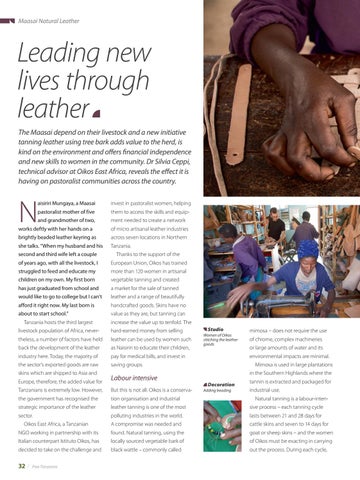Maasai Natural Leather
Leading new lives through leather The Maasai depend on their livestock and a new initiative tanning leather using tree bark adds value to the herd, is kind on the environment and offers financial independence and new skills to women in the community. Dr Silvia Ceppi, technical advisor at Oikos East Africa, reveals the effect it is having on pastoralist communities across the country.
N
aisiriri Mungaya, a Maasai
invest in pastoralist women, helping
pastoralist mother of five
them to access the skills and equip-
and grandmother of two,
ment needed to create a network
works deftly with her hands on a
of micro artisanal leather industries
brightly beaded leather keyring as
across seven locations in Northern
she talks. “When my husband and his
Tanzania.
second and third wife left a couple
Thanks to the support of the
of years ago, with all the livestock, I
European Union, Oikos has trained
struggled to feed and educate my
more than 120 women in artisanal
children on my own. My first born
vegetable tanning and created
has just graduated from school and
a market for the sale of tanned
would like to go to college but I can’t
leather and a range of beautifully
afford it right now. My last born is
handcrafted goods. Skins have no
about to start school.”
value as they are, but tanning can
Tanzania hosts the third largest
increase the value up to tenfold. The
livestock population of Africa, never-
hard-earned money from selling
theless, a number of factors have held
leather can be used by women such
back the development of the leather
as Naisiriri to educate their children,
industry here. Today, the majority of
pay for medical bills, and invest in
the sector’s exported goods are raw
saving groups.
skins which are shipped to Asia and
Studio Women of Oikos stitching the leather goods
mimosa – does not require the use of chrome, complex machineries or large amounts of water and its environmental impacts are minimal. Mimosa is used in large plantations in the Southern Highlands where the
Europe, therefore, the added value for
Labour intensive
Tanzanians is extremely low. However,
But this is not all. Oikos is a conserva-
the government has recognised the
tion organisation and industrial
strategic importance of the leather
leather tanning is one of the most
sive process – each tanning cycle
sector.
polluting industries in the world.
lasts between 21 and 28 days for
A compromise was needed and
cattle skins and seven to 14 days for
NGO working in partnership with its
found. Natural tanning, using the
goat or sheep skins – and the women
Italian counterpart Istituto Oikos, has
locally sourced vegetable bark of
of Oikos must be exacting in carrying
decided to take on the challenge and
black wattle – commonly called
out the process. During each cycle,
Oikos East Africa, a Tanzanian
32
Paa Tanzania
Decoration Adding beading
tannin is extracted and packaged for industrial use. Natural tanning is a labour-inten-



